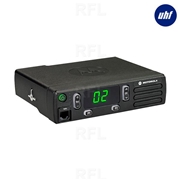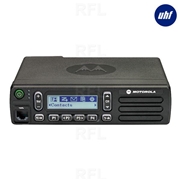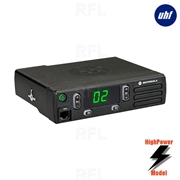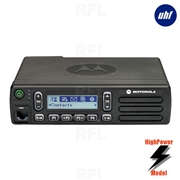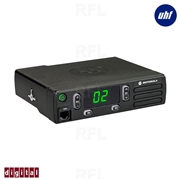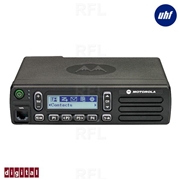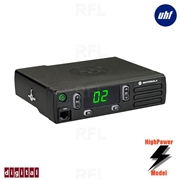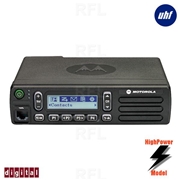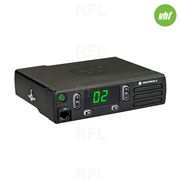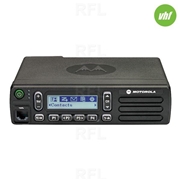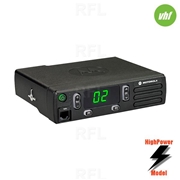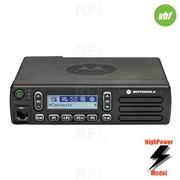Motorola Mobile Radios – exceptional dependability
Your people are on the move, delivering cargo, picking up consignments, driving children to and from school. You need to keep them in touch and on track efficiently. And you want to make sure the radios they use are as affordable and adaptable as possible.
The rugged MOTOTRBO CM200d and CM300d radios offer all the benefits of the latest technology – twice the capacity, greater coverage and superior audio. These affordable mobiles are compatible with the MOTOTRBO features you’ll find are business-essential, for example a transmission can be interrupted to prioritize critical communications.
Motorola Commercial Mobile Radios
The CM200d and CM300d are so easy to use and deliver such clear voice communications, you’ll be amazed how efficient your operation can be. Motorola's Mobile Radios provide crisp, continuous and high-quality communications for your in-vehicle needs.The series of Mobile Radios was designed for reliability and durability so that your team can communicate easily and comfortably.
When it comes to two-way radio communications, Motorola is the unsurpassed leader in quality and performance. These Motorola portable two-way radios will let you communicate efficiently with your people and increase your productivity. With a mobile team of employees, safety and productivity are vital to your organization. With a wide variety of models and features, Motorola's two-way mobile radios are an ideal solution of your communication needs. Don’t sacrifice ruggedness for functionality. Large controls, 4-watt speakers and color LED indicators let drivers keep their eyes on the road instead of the radio. Compact size suits in-vehicle and dispatch use.
Number of Users / Channels
The number of individual users as well as the number of talk groups you need to maintain determines the number of channels you will require in a radio. For example, if you wish a certain department to maintain its talk group, it would
require a dedicated channel for that department. If two or more individuals need to maintain private communications, a dedicated channel would be required. It is not uncommon to have multiple channels within a department for special projects
where more than one operation or event is occurring simultaneously. In addition, the use of digital technology increases the capacity of your system by dividing your existing channels into two time slots. This enables you to double the
number of users on your system without the need for additional infrastructure equipment. Lastly, when making decisions regarding the number of channels you require, it is essential to keep future expansion in mind.
Frequency Band
For most general applications, there are 3 categories of frequency bands to consider:
- VHF (Very High Frequency) at 136-174 MHz
- UHF (Ultra High Frequency) at 403-512 MHz
- 800 / 900 MHz
All bands have advantages for specific applications. As a rule, the higher the frequency, the better the in-building penetration. However, as you increase in frequency, you will decrease in range. VHF frequencies (136-174) are better suited for outdoor applications where maximum range is required with little to no obstructions. UHF and the 800 / 900 MHz frequencies are better suited for indoor applications or environments with obstructions. VHF and UHF frequency bands are typically used for conventional two-way radios systems, while 800 / 900 MHz frequency bands are commonly used for trunking two-way radio systems.
Features:
A wide variety of features are available to help increase the efficiency, productivity and safety of your workforce. Efficiency/productivity features include integrated data applications that increase a radio's capability beyond voice
communication, and telephone interconnect, which enables radios to talk with a telephone PBX system. Safety features include emergency notification for use during urgent situations and intrinsically safe certifications for hazardous work
environments.
- Telephone Interconnect:
Telephone Interconnect is a feature that enables a radio system to be connected to a telephone PBX system, which allows radios to make phone calls using the radio keypad.
- Technology:
Two-way radios have traditionally used analog technology. Digital technology is the next generation of two-way radio and offers several advantages over analog including clearer audio, integrated data applications, 40% longer battery life
and increased capacity. The choice between analog radios and digital radios is not that difficult. If you have an existing radio fleet and are currently using analog radios, your investment is safe for many years to come. If you're considering
new radios for a new fleet or a new project, the digital alternative offers advantages over the analog technology. Motorola also offers a hybrid solution that gives you the best of both worlds. - Still confuse, were here to help.
- Third-Party Data Applications:
Third-Party Data Applications expand the functionality of digital radios by enabling customized applications to be built for your unique business needs including dispatch solutions, work order ticket management, system monitoring
and much more.
- Trunking:
Trunking is a radio system configuration that uses a control channel to efficiently organize the radios and conversations on your radio system. This enables numerous radio users to operate on the same system.
- Emergency Call:
Emergency Call allows a radio user, with the push of a button, to send a distress message to all other radios users to indicate an emergency and be given priority to talk.
- Quik-Call Signaling:
Quik-Call II signaling is an analog two-tone format used for paging over a two-way voice channel. The decoding of tones allows the radio to receive only messages intended for its specific user, and activates that radio when to start
listening to a conversation. The encoding of tones allows the radios to send such messages to specific units. This is a feature commonly used by rural fire departments.
- DTMF Signaling:
Dual-Tone Multi-Frequency (DTMF) Signaling enables radio users to use the radio keypad to control another device that is pre-programmed to recognize the tones as commands. This feature is commonly used to open/close gates, turn off/on
sprinkling systems, or place a phone call using the telephone interconnect feature.
- MDC 1200 Signaling:
MDC 1200 Signaling uses low speed data packet transmissions that grants radio users access to a number of enhanced features such as unit ID, selective inhibit, radio check and selective calling.
- Enhanced / Basic Privacy:
Enhanced / Basic Privacy is a technology that allows a transmitting radio to send out a scrambled audio signal and a receiving radio to unscramble that signal. This helps to prevent unauthorized users from listening to sensitive communications.

